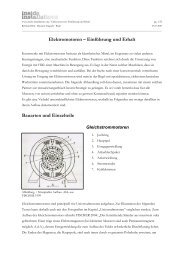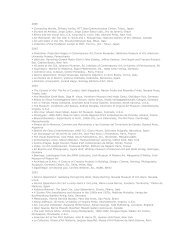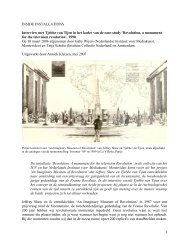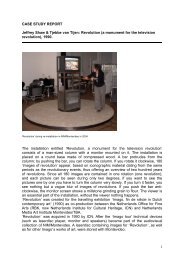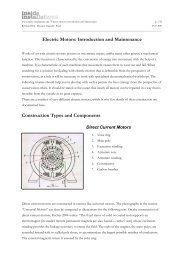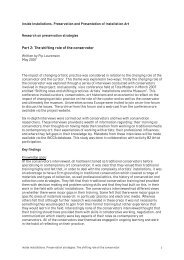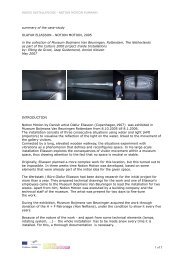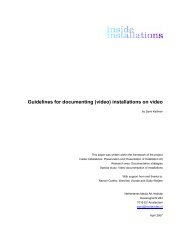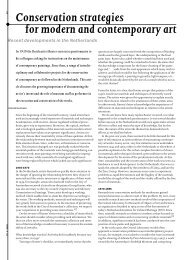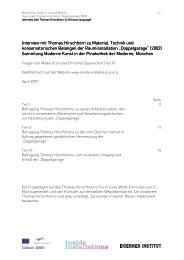GLOSSARY OF LIGHT TECHNOLOGY - Inside Installations
GLOSSARY OF LIGHT TECHNOLOGY - Inside Installations
GLOSSARY OF LIGHT TECHNOLOGY - Inside Installations
Create successful ePaper yourself
Turn your PDF publications into a flip-book with our unique Google optimized e-Paper software.
WWW.INSIDE-INSTALLATIONS.ORG GBLOSSARY <strong>OF</strong> <strong>LIGHT</strong> <strong>TECHNOLOGY</strong> FRANZISKA HERZOG ZKM KARLSRUHE 10<br />
Dimmers<br />
cont.<br />
Direct Current<br />
Direct Voltage<br />
Disposal<br />
DMX<br />
(DMX 512 as well as DMX-512/<br />
1990)<br />
Earthing<br />
Electric Light Sources<br />
Electrical Current (I)<br />
Electrical Power (P)<br />
Formula: P = U · I<br />
U|Electrical Voltage in Volt<br />
I|Current Intensity in Ampere<br />
Electrical Resistance (R)<br />
Formula: R = U / I<br />
U|Electrical Voltage in Volt<br />
I|Current Intensity in Ampere<br />
With > gas discharge lamps, for example, the minimum voltage for the<br />
service of the light source must be guaranteed so that the discharge<br />
is maintained despite the dimming and the lamp is not extinguished.<br />
> electrical current<br />
> electrical voltage<br />
of old lamps has been defined since 2005 by common European<br />
regulations. These regulations correspond to the code 2002/96/EG<br />
for defunct electrical devices and defunct electronic devices. The<br />
regulations are divided into ten categories whereby number five deals<br />
with lighting installations. All lamps containing mercury (almost<br />
all > gas discharge lamps, e.g.> fluorescent lamps) must be properly<br />
disposed of. > Incandescent lamps and > halogen lamps are not dealt<br />
with in these regulations.<br />
is the abbreviation for Digital Multiplex and is a digital control<br />
protocol used in stage and show lighting to control > dimmers, ><br />
spotlights or stroboscopes, for example.<br />
It enables high flexibility of the composition of time and special<br />
effects. 512 Channels can be transmitted with an 8 bit resolution (265<br />
stages) per connection. DMX has a high protection against disturbances<br />
due to a symmetrical transmission process.<br />
refers to the electrically conductive connection with the earth<br />
potential, which is implemented for the purpose of technical safety.<br />
The earth enables a defined connection potential or a potential balance<br />
to be created. This is meant to prevent possible occurrences of ><br />
electrical voltage and thus dangerous body currents.<br />
Because the earth always exhibits > electrical resistance, a low<br />
electrical voltage remains in the case of a permanent current flow.<br />
also commonly referred to as > lamps they are characterised by the<br />
emission of visible, artificial light.<br />
They include > lamps, i.e. light media, and > the lighting fixture.<br />
Light sources are categorised according to their principle of light<br />
generation into > thermal radiators, > electrical luminescence<br />
radiators and plasma radiators (> gas discharge lamps).<br />
is the directed movement of free electrons in an electrical<br />
conductor and is measured in amperes (A).<br />
The source of electrical current is the > electrical voltage which<br />
causes the movement of the electrons.<br />
The current intensity (I) indicates how many load carriers flow<br />
through an electrical conductor in a particular time.<br />
The original definition, that the current flows from the positive<br />
pole to the negative pole (called the technical current direction),<br />
is derived from the magnetic fields produced by the movement of<br />
electrons. The behaviour is actually the opposite (called the<br />
physical current direction).<br />
A distinction is made between alternating current (AC) and direct<br />
current (DC). The abbreviations AC and DC are found on the housing<br />
of electrical devices. Direct current (DC) displays a constant<br />
voltage and current course. Alternating current (AC) alternates<br />
direction periodically whereby a convenient transformation of the<br />
current|voltage is possible even over great distances.<br />
refers to the work, i.e. energy, of a load (> lamp, > light source)<br />
in a particular time. It is measured in watts (W).<br />
refers to the property of certain electrical components to limit the<br />
current flow. It is measured in Ohms (Ω).<br />
According to Ohms Law an electrical conductor imposes resistance on<br />
the electrons (direct current resistance) as soon as the electrons<br />
collide with atoms as they pass through and conductor. The result is<br />
a loss of energy in the form of heat.<br />
The more the voltage must be increased to achieve a current flow in<br />
the conductor|component, the greater the resistance and the lower<br />
the conduction (formula symbol G with the unit of measurement S for<br />
Siemens).



